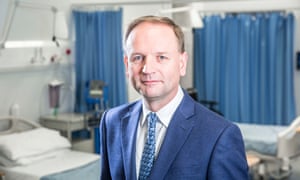The NHS has been accused of a “disgraceful” failure to use the talents of women and people from ethnic minorities after new research revealed that they are badly under-represented in senior positions.
Despite a two-year drive to rectify the problem, far fewer people from both groups chair an NHS acute hospital trust or ambulance trust in England than would be proportionate to their numbers in the population, freedom of information responses show. They are also much less likely to be non-executive directors of them than white men.
Only 2% of NHS trusts, which decide how health services are run, are chaired by people from a black and minority ethnic (BME) background, even though 15% of England’s population is of BME heritage. While 80% of NHS staff are women, they make up just 28% of trust chairs, outnumbered three to one by men – prompting the claim that white, male NHS leaders are simply appointing people like them.
Related: Inequality rife among black and minority ethnic staff in the NHS
“The lack of women chairs is bad enough. But the BME proportions are disgraceful,” said Lord Philip Hunt, the Labour shadow health minister in the House of Lords, who was the chair of the Heart of England hospital trust in Birmingham for four years until 2014. There are 156 acute hospital trusts and ten regional ambulance service trusts, which between them receive over £40bn a year of the NHS budget for caring for patients.
Hunt accused the mainly white male chairs of trusts of perpetuating the acknowledged problem of too few women and non-white faces in positions of authority by ignoring suitably qualified people from the local area who would change the mix. “Too many chairmen want to appoint executives who are in their own image,” he said.
Hunt said the findings, based on data from about 1,450 board members at 114 trusts, showed that despite repeated pledges and a range of initiatives to improve gender and BME representation, the NHS has had limited success in tackling huge under-representation in top jobs, which it called its “snowy white peaks”.
They appear to indicate that Simon Stevens, NHS England’s chief executive, has achieved little in his drive over the last two years to improve the number of BME people moving into top jobs. “The barriers for people from a BME background in getting top executive positions have been well-documented and there is little sign of much progress,” added Hunt.
The report, called Action not words – Making NHS boards more representative says: “It is clear that the NHS has a long way to go before the boards of acute and ambulance trusts are anywhere near reflecting the ethnic and gender balance of the population. This is a serious weakness which needs to be rectified as a matter of priority.” The study suggests that the NHS may not easily meet its ambition of having a 50/50 gender split on boards by 2020.

Noting the apparent failure of schemes to improve things, it adds: “Good intentions and platitudes are not sufficient. There is a clear need for the government to step in and insist that NHS trust boards undertake a radical transformation to reflect the communities they serve.”
The data supplied by trusts also shows that:
- People from a BME background make up just 4% of the executive directors and 7% of non-executive directors on trust boards
- While 47% of trusts’ executive directors are female, women comprise just 38% of the non-executive roles on boards
- Three-quarters (75%) of NHS trust chairs are aged 60 or over, while just under half (46%) of non-executive directors are in the same age bracket
Stevens recently reiterated that the NHS had to become much better at appointing those from a BME background to senior roles because research shows it leads to better care. “We know that care is far more likely to meet the needs of all patients we’re here to service when NHS leadership is drawn from diverse communities across the country, and when our frontline staff are themselves free from discrimination.”
NHS England last year appointed two new senior staff to boost BME representation. They included Roger Kline, who undertook seminal research at Middlesex University in 2014 that lamented NHS leadership in London as overwhelmingly white. It has also introduced an NHS workforce race equality standard, which requires trust to increase the number of people of a BME background in senior positions.
An NHS England spokesperson said: “This is an issue that the NHS must address. That’s why in June this year we published the first NHS workforce race equality standard (WRES), report which gave feedback to every hospital and trust across the NHS about the experiences of their BME staff. While some employers have got it right, we know there’s a long way to go, and this first annual survey provides a transparent baseline from which we expect to see improvement.
“We’re investing £2m over two years (2015-17) in the WRES programme to improve equality in recruitment, board membership and career opportunities. This includes training and developing 75 champions based in trusts who will help reduce inequality and spread best practice,” the spokesperson added.
Women and BME community markedly under-represented in top NHS roles
Hiç yorum yok:
Yorum Gönder